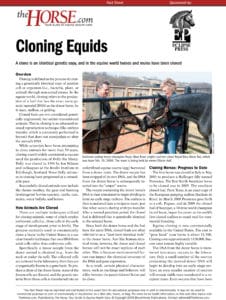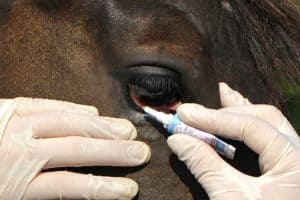
Ultrasonography for Horses
Equine practitioners use ultrasound machines to help diagnose a number of physical abnormalities.


Equine practitioners use ultrasound machines to help diagnose a number of physical abnormalities.

Cloning is defined as the process of creating a genetically identical copy of another cell or organism (i.e., bacteria, plant or animal) through non-sexual means.
Do you have questions about how best to deworm your horses? You’re not the only one! Join us for the extended Ask the Vet LIVE Q&A chat event on Parasite Basics and Deworming Tuesday April 27, from 2-3 p.m. EST.
The Raleigh, N.C.-based News & Observer reported that a miniature donkey died of rabies last week on a Durham County goat farm. It is unknown how the donkey was exposed to the virus, but animal control officers suspect “Eddie” was infected by a wild animal passing through his pasture.

Dr. Claire Latimer discusses equine opthalmology and how to give eye medications to a horse.

Not sure which shots? Dr. Rocky Mason of Hagyard Equine Medical Institute discusses annual equine vaccinations.
Stephanie L. Church has been named Editor-in-Chief of The Horse, and will lead all editorial initiatives for both print and digital media platforms. Stephanie succeeds Kimberly S. Brown, who has left the company to pursue other business
Stephanie L. Church has been named Editor-in-Chief of The Horse, and will lead all editorial initiatives for both print and digital media platforms. Stephanie succeeds Kimberly S. Brown, who has left the company to pursue other business interests.
Olympic dressage rider Courtney King-Dye was hospitalized after suffering a skull fracture when a young horse she was schooling slipped and fell last Wednesday.

The 55th Annual Convention of the American Association of Equine Practitioners
(AAEP) attracted a record crowd to Las Vegas, Nev., Dec. 5-9, 2009.
Attendees participated in scientific lectures, industry forums, networking
events, and other opportunities for professional development.

During each convention of the American Association of Equine Practitioners, one veterinarian is chosen for the honor of giving the Frank J. Milne State-of-the-Art Lecture on a topic of importance to the profession. In 2009 Larry Bramlage, DVM, MS, Dipl. ACVS, was selected to discuss the orthopedics of the horse’s fetlock joint, from disease and injury to surgical repair.
“There’s a large part of the world that depends more than ever on working equids,” said Jay Merriam, DVM, of Massachusetts Equine Clinic, in Uxbridge, who moderated the first-ever AAEP convention session on equitarian initiatives (2009). Merriam defined an equitarian as “one who serves equids with compassion, and whose only reward is their improved health and welfare.”

The hottest news in equine veterinary medicine in 2009 included a lethal medication compounding error, genetic deafness in Paint horses, bacteremia in foals, piroplasmosis, exercise-induced pulmonary hemorrhage, and more. (Presented at the Kester News Hour session, American Association of Equine Practitioners Convention, 2009)

Several topics related to lameness in horses were presented at the 2009 American Association of Equine Practitioners convention, from racehorse lameness to regional limb perfusion, nerve blocks, and radiographic findings in Quarter Horses.

Treatments for lameness in horses, including tenotomy surgery for laminitis, arthritis treatments, stem cells, maggots for wound therapy, electrotherapy, manual therapies, and more were discussed at the 2009 convention of the American Association of Equine Practitioners.

Updates on preparing for colic, enteroliths, tapeworm colic, and cortisol hormone levels in colicky horses, from the 2009 convention of the American Association of Equine Practitioners.
Stay on top of the most recent Horse Health news with